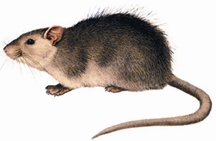Rat

Rat long-tailed rodent of the order Rodentia and family Muridae, of the genus Rattus and related genera, distinguished from the mouse by being larger. Rats have more rows of scales on the tail (up to 210 or more) than mice, in which the number does not exceed 180. rodents are highly adaptable and opportunistic mammals, and are found in all terrestrial habitats in every continent except Antarctica. The success of rodents as a group can be attributed to their unselective, generalized feeding habits and to their enormous capacity of reproduction, which enables to adapt rapidly to changing environmental conditions. The order Rodentia can be divided into 3 major groups on the basis of the arrangement of the jaw muscles and various associated features of the skull.
One group contains the squirrel-like rodents, another the cavy-like rodents, and a third the rat and mouse like rodents. More than a quarter of all mammal species belong to the third group. Family Muridae contains over 1,000 species. Bangladesh has 10 species of rats and one species of mouse.
Indur (Indian Mole Rat/Lesser Bandicoot Rat, Bandicota bengalensis); Dhadi Indur (Bandicoot Rat/Large Bandicoot Rat/Greater Bandicoot Rat, Bandicota indica); Metad Rat/Soft-furred Rat/Soft-furred Field Rat (Millardia meltada); Metho Indur (Indian Field Mouse/Little Indian Field Mouse, Mus booduga); Nengti Indur (House Mouse, Mus musculus); Short-tailed Bandicoot Rat/Short-tailed Mole Rat (Nesokia indica); Bram Rat (Rattus norvegicus); Indur (Common House Rat/Black Rat, Rattus rattus); Kangaru Indur (Antelope Rat/Indian Gerbil, Tatera indica); Long-tailed Tree Mouse/Indian Long-tailed Tree Mouse/Palm Mouse (Vandeleuria oleracea); Bay Bamboo Rat/Lesser Bamboo Rat (Cannomys badius).
These rodents are typically short-lived but capable of prolific breeding from an early age. They have short oestrus cycles and gestation periods, and long breeding seasons. Some rats and mice are sexually mature by 2 months, produce up to 8 young per litter after a gestation period of only 3 weeks, and can breed again 3-4 weeks later. However, they rarely live longer than two years. Many species of rat and mouse continue to have a major impact on mankind as pest of stored food products. They are also important transmitters of disease, and over 20 pathogens are carried by them. Among these is the bacterium that causes bubonic plague (‘the black death’), which is transmitted to humans by the bite of the rat flea.
Despite their bad reputation as pests and carriers of disease, rodents are also useful to mankind. It is a source of meat for many indigenous people. The domesticated house mouse and brown rat are probably the most widely used animals in laboratory research and in the testing of drugs and other products. [Md Anwarul Islam]
